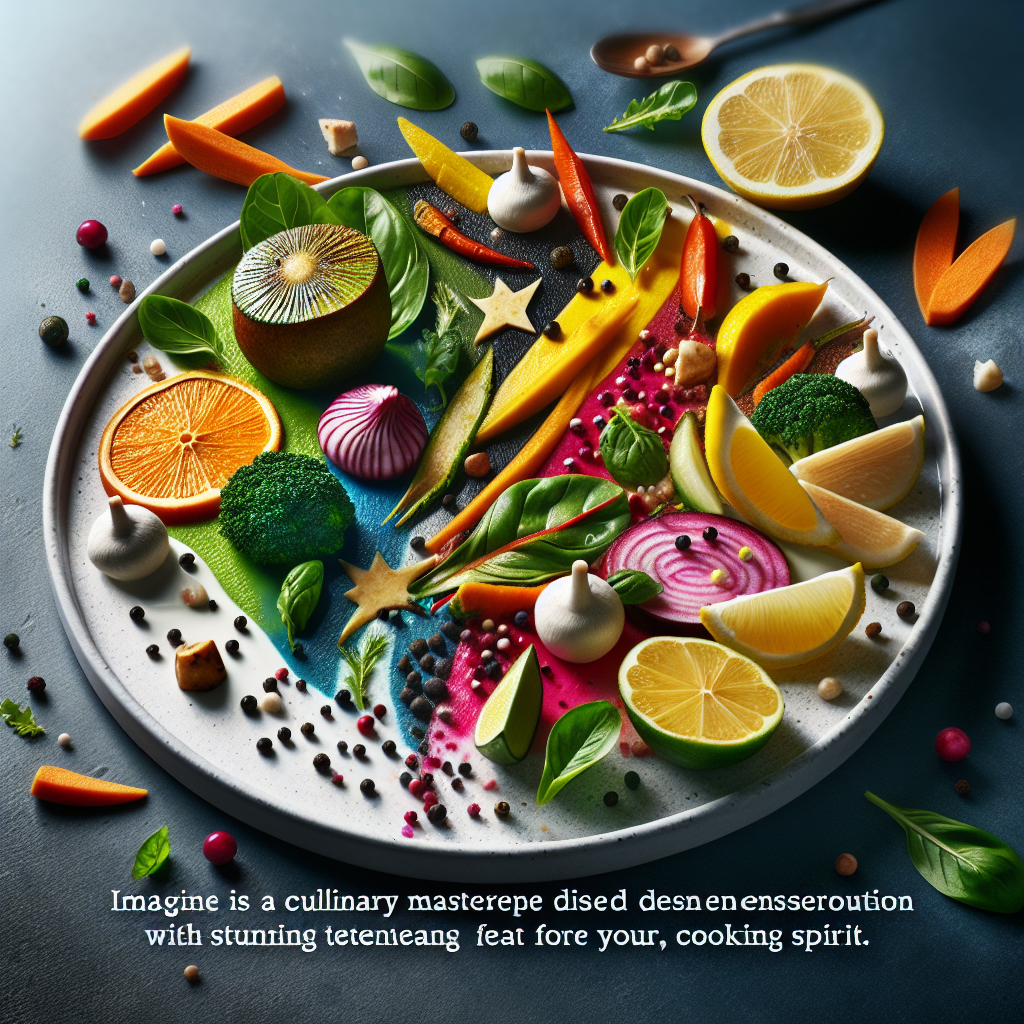Are you a teenager looking to take your cooking skills to the next level? Look no further! Tastepan’s expert cooking tips and techniques are here to help you master the art of food plating. Whether you want to impress your friends and family with a visually stunning dish or simply enhance your culinary creativity, our comprehensive guides and videos will turn you into a kitchen pro. Get ready to unleash your inner chef and learn the secrets of food plating for teens.

Choosing the Right Plates and Utensils
When it comes to creating visually appealing dishes, the size and shape of the plates play a crucial role. Choosing the right plates can enhance the presentation of your food. For example, if you are serving a delicate dish, opt for smaller plates to make it look more elegant. On the other hand, if you want to create a stunning display of a colorful salad, using larger plates can help showcase the vibrant ingredients.
Apart from the size, the shape of the plates also matters. Rectangular plates can give a modern and sleek look to your presentation, while round plates provide a classic and timeless appearance. Consider the overall theme and style of your dish when selecting the shape of the plates.
Moving on to utensils, the type of utensils you use can greatly impact the overall presentation. For example, using long-handled spoons or tweezers can help you meticulously arrange smaller ingredients with precision. Additionally, incorporating unique and stylish serving spoons, forks, and knives can add a touch of elegance to the plating.
Colorful and Vibrant Ingredients
The use of colorful ingredients is key to creating visually appealing dishes. Colors not only make the food more enticing but also indicate the presence of different nutrients. Incorporating a variety of fruits and vegetables in your dishes ensures a beautiful assortment of colors.
When selecting fruits and vegetables, think beyond the usual suspects. Experiment with exotic options like dragon fruit, purple cauliflower, or heirloom tomatoes to add a pop of vibrant hues. Incorporating edible flowers, such as pansies or nasturtiums, can also bring a touch of natural beauty to your plate.

Creating Contrast and Balance
Contrasting colors and textures in your dish can create visual interest and make it more appealing to the eye. Think about incorporating ingredients of different colors, such as pairing bright red tomatoes with vibrant green lettuce. The contrast between these colors will make the dish more visually striking.
Balance is another key factor in creating an aesthetically pleasing plate. Balancing different food groups, such as having a mix of proteins, vegetables, and grains, ensures that your dish looks well-rounded and satisfying. This can also enhance the flavors and create a harmonious balance in every bite.
Mixing hot and cold elements in your dish can add another layer of contrast and surprise. Combining a warm protein with a cool salad, for example, creates a delightful play of temperatures that can elevate the overall dining experience.
Focus on Presentation Techniques
Presentation techniques are essential when it comes to making your dish visually appealing. Layering and stacking can add depth and dimension to your plate. For example, you can layer different colored vegetables or stack protein and carbs for an artistic arrangement.
Arranging food in a symmetric pattern is another effective way to create an organized and visually pleasing plate. Think about dividing the plate into halves or quarters and placing different elements in each section. This technique allows the eyes to move around the plate, taking in the various components.
Using molds and cutters can help you shape your ingredients into unique forms. Play with different shapes and sizes to create a visually stunning display. Whether it’s using a ring mold to shape rice or cutting vegetables into different geometric shapes, these techniques can add a stylish touch to your plating.

Garnishing and Decoration
Garnishes and decorations can take your dish from ordinary to extraordinary. Fresh herbs and spices not only add flavor but also bring a burst of color to your plate. Sprinkle some chopped herbs, such as parsley or basil, on top of your dish to add a touch of vibrancy.
Sauces and drizzles can also be used to enhance the visual appeal of your dish. Consider creating a beautiful swirl or pattern with a vibrant sauce that complements the flavors of your main ingredients. Drizzling sauces on the plate not only adds visual interest but also gives the dish a professional touch.
Edible garnishes, such as edible flowers or microgreens, can be used to add an element of elegance to your dish. These small details can make a big difference in the overall presentation. Experiment with different edible garnishes and see which combinations work best for your dishes.
Playing with Height and Levels
Creating different levels on your plate can add visual interest and make your dish stand out. Using pedestals or risers can elevate certain elements, making them more prominent. For example, placing a sauce or drizzle in a small dish on top of a pedestal can draw attention to it.
Stacking ingredients vertically can also create a dynamic and visually appealing dish. Think about layering different components to create height and balance. For instance, layering vegetables, proteins, and grains in a vertical arrangement can create a striking presentation.
Creating visual interest with different levels can be achieved by strategically placing ingredients at varying heights. This can be accomplished by using items like stacked pancakes or placing a scoop of ice cream on top of a piece of cake. Playing with different levels adds depth and dimension to your plate.
Incorporating Food Art
Food art is a creative way to present your dishes and impress your guests. You can create shapes and patterns with ingredients to add an artistic touch. For example, use thinly sliced vegetables to create a stunning flower design or arrange fruit slices into intricate patterns.
Arranging ingredients to resemble animals or objects can be a fun and playful way to showcase your culinary skills. For example, you can arrange grilled vegetables to resemble a butterfly or create a smiley face using various ingredients. Food art allows you to express your creativity while making your dishes visually captivating.
Using food as a canvas for drawings is another way to incorporate food art into your plating. Whether it’s drawing a simple design with sauce or creating a more elaborate masterpiece with colored purees, this technique can transform your dish into a work of art.
Embracing Minimalism
Sometimes, less is more when it comes to food presentation. Embracing simplicity and elegance in plating can create a visually stunning dish. Allow the natural beauty and colors of the ingredients to shine through by keeping the presentation minimalistic.
Using negative space on the plate can have a powerful visual impact. Leave empty spaces around the main components of your dish to draw attention to them. This technique can create a sense of elegance and sophistication.
Letting the food speak for itself is another key aspect of minimalist plating. Instead of relying on excessive garnishes or elaborate decorations, focus on highlighting the flavors and textures of the main ingredients. This approach creates a clean and sophisticated presentation that is pleasing to both the eyes and the palate.
Adding Texture and Crunch
Texture plays a vital role in food presentation. Incorporating crispy elements can add a delightful crunch to your dish and provide a contrast to softer components. Think about adding crispy toppings like fried onions, toasted nuts, or croutons to enhance the texture.
Using a variety of textures in the dish can create a more interesting and engaging eating experience. For example, combine creamy elements with crunchy vegetables or incorporate chewy components with a tender protein. This combination of textures adds depth to the dish and keeps it visually engaging.
Nuts, seeds, or croutons can be added for an extra crunch in your dish. They not only provide a textural contrast but also add flavor and visual interest. Sprinkle them on top of salads, soups, or main dishes to elevate the overall presentation.
Experimenting with Plating Styles
Traditional plating techniques are classic and timeless. These techniques involve arranging the main ingredients in the center of the plate and placing complementary elements around them. This method ensures a balanced and visually appealing presentation.
Modern and artistic plating styles offer a more contemporary and unique approach to food presentation. These styles often involve abstract designs, asymmetrical arrangements, and playful placements. Experimenting with these styles can add a touch of creativity and flair to your dishes.
Fusion of different plating styles can result in a truly innovative and visually stunning presentation. Combining elements from traditional, modern, and cultural plating styles allows you to create your own unique approach. Mix and match techniques to find a style that best suits your culinary creations.
In conclusion, food plating is an art that involves careful consideration of plates, utensils, ingredients, presentation techniques, garnishes, and plating styles. By paying attention to these aspects, you can take your culinary creations to the next level and impress your guests with not only the taste but also the visual appeal of your dishes. Remember, creativity and experimentation are key, so don’t be afraid to let your imagination run wild when it comes to plating your meals. Happy plating!

